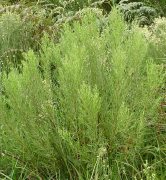Do blog: http://naturaetchimia.wordpress.com/

And here goes to you a little more of our ongoing research on Baccharis volatile secondary metabolites, this time showing what is going on with the rebel Baccharis rufescens in our region.
This species belongs to the section Cylindricae, and it was for us a surprise that two other species of this section we found here in the Second Planalto of Paraná, Brazil, B. pentodonta and B. tridentata are also endowed with strong roots.
Baccharis rufescens is a herbaceous plant, apparently without use in Brazilian traditional medicine. The literature reports earlier chemical and pharmacological studies conducted in Argentina. The anti-inflammatory activity of extracts from the aerial parts of the plant, identified as B. rufescens var. rufescens, was investigated in mice subjected to the paw edema induced by carrageenan. The extracts prepared with acetone and chloroform, injected intraperitoneally in doses equivalent to 80 mg/kg of plant material, inhibited the acute phase of inflammation in this model [1]. Chemical studies of the leaves of this variety led to the isolation of flavonoids cirsimaritin and cirsiliol, oleanolic acid and a ent-kauran diterpene, that showed significant activity on decreasing the appetite of Trilobium castaneum adults [2]. The essential oil from aerial parts of B. rufescens collected in Argentina presented limonene (14.4%) and trans-nerolidol (15.5%) as main components [3].
Among the biological activities of secondary metabolites already isolated from B. rufescens, we highlight those presented by flavonoids. The cirsimaritin (5,4′-dihydroxy-6,7-dimethoxyflavone) showed strong antimicrobial activity compared to other flavonoids [4]. Just as its 4′-glucoside (cirsimarin) this flavonoid proved to be a strong inhibitor of adenosine in vitro and in vivo, eventually being recognized as a potentially effective drug against proteinuria [5]. And besides its diazepine receptor binding (IC50 350 mM) [6], cirsimaritin has antimutagenic activity [7], and anticancer [8]. Meanwhile, the cirsiliol (5,3′,4′-trihydroxy-6,7-dimethoxyflavone) has already been patented in the U.S. for use as antiviral, especially against the influenza virus [9], and has strong anti-inflammatory activity [10].
Essential oil studies
An important scientific question focuses on metabolic differences between male and female specimens of Baccharis species. Until recently, all published studies showed large differences in the compositions of the essential oils of male and female specimens of Baccharis species [11-14]. We have studied this issue in recent years and could contribute significantly demonstrating for five species of the genus Baccharis, that is possible to find the moment during the flowering period, in which male and female specimens exhibit volatile secondary metabolites with very similar compositions [15 ]. When plant material of male and female specimens are collected at the same place and at the same time, the differences between the compositions of essential oils tend to disappear. Genetic differences are smaller or nonexistent within a population restricted to a small defined area, and ecological differences are also smaller in these conditions, favoring the similarity in the compositions of the volatile metabolites of both specimens.
In the last few years we have several times collected male and female specimens of Baccharis rufescens, which grows in nature in this region of the Second Paraná Plateau, to analyze volatile compounds by GC-MS-FID. This is the first systematic study on the chemical constituents of male and female specimens essential oils from this plant. The results have always indicated high proportions of (E)-nerolidol in female specimens and benzyl benzoate in the male specimens. Perhaps this constant difference can be attributed to an infestation by microorganisms or interaction with insects, probably only affecting the male specimens of the plant, what requires further studies and field observations to clarify the case. This difference remains as a rebelliousness of the plant, who insists on keeping his secret…
References
[1] Cifuente, D.A., Simirgiotis, M.J., Favier, L.S., Rotelli, A.E., Pelzer, L.E. Antiinflammatory activity from aerial parts of Baccharis medullosa, Baccharis rufescens and Laennecia sophiifolia in mice. Phytotherapy Research 15(6): 529-531, 2001.
[2] Simigiortis, M.J., Garcia, M., Sosa, M.E., Giordano, O.S. Tonn, C.E. An ent-kaurene derivative from aerial parts of Baccharis rufescens. The Journal of Argentine Chemical Society 91(4/6): 109-116, 2003.
[3] Zunino, M.P., Newton, M. N., Maestri, D.M., Zygadlo, J.A. Essential oils of three Baccharis species. Planta Medica 64(1): 86-87, 1998.
[4] Miski, M., Ulubelen, A., Johansson, C. Antibacterial activity studies of flavonoids from Salvia palaestina. Journal of Natural Products 46(6): 874-875, 1983.
[5] Hasrat, J.A., De Bruyne, T., De Backer, J.P., Vauquelin, G., Vlietinck, A.J. Cirsimarin and cirsimaritin, flavonoids of Microtea debilis (Phytolaccaceae) with adenosine antagonistic properties in rats: leads for new therapeutics in acute renal failure. Journal of Pharmacy and Pharmacology 49(11): 1150-1156, 1997.
[6] Kavvadias, D., Monschein, V., Sand, P., Riederer, P., Schreier, P. Constituents of Sage (Salvia officinalis) with in vitro affinity to human brain benzodiazepine receptor.Planta Medica 69(2): 113-117, 2003.
[7] Nakasugi, T., Komai, K. Antimutagens in the Brazilian folk medicinal plant carqueja (Baccharis trimera Less.). Journal of Agriculture and Food Chemistry 46(7): 2560-2564, 1998.
[8] Quana, Z., Gua, J., Donga, P., Lua, J., Wub, X., Wub, W., Feib, X., Lia, S., Wang, Y., Wang, J., Liua, Y. Reactive oxygen species-mediated endoplasmic reticulum stress and mitochondrial dysfunction contribute to cirsimaritin-induced apoptosis in human gallbladder carcinoma GBC-SD cells. Cancer Letters 295(2): 252-259, 2010.
[9] Prendergast, P.T. Use of cirsiliol and derivatives to treat infections. US Patent6555523, 2003.
[10] Tsukada, T., Nakashima, K., Shirakawa, S. Arachidonate 5-lipoxygenase inhibitors show potent antiproliferative effects on human leukemia cell lines.Biochemical and Biophysical Research Communications 140(3): 832-836, 1986.



Nenhum comentário:
Postar um comentário